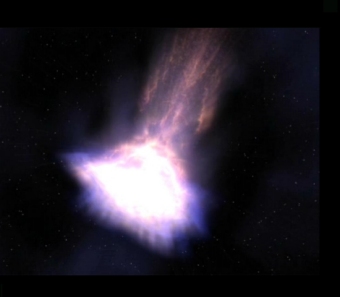
A particle fountain is a small but dangerous spatial
anomaly that was encountered in an episode of Star Trek: Voyager,
"Alice". In that episode, the sentient ship Alice compelled Tom Paris
to take "her" to a particle fountain, describing it as her "home".
Starfleet is said to have lost over a dozen ships attempting to study
particle fountains and, consequently, the phenomenon was
poorly-understood.
Little is known about interstellar particles in real
astrophysics. The major form of heavy elements in interstellar space is
in dust. This interstellar dust plays a major role in the formation of
new stars and planetary systems. Our own Solar System formed from gas
and dust in the interstellar medium 4.6 billion years ago. The heavy
elements making up Earth and our bodies were once interstellar dust.
But we don't even know what the typical interstellar dust grain looks
like.
Interstellar dust was first discovered flowing across
the Solar System by dust detectors aboard the Ulysses spacecraft in
1993 and was later confirmed by the Galileo mission to Jupiter. The
particles were identified as coming from a location in the sky in the
Constellation Ophiuchus, looking toward the center of the Milky Way
Galaxy. Interstellar dust is small, ranging in size from 0.01 microns
all the way up to 20 microns. They are made of different minerals such
as silicates, graphitic carbon, hydrogenated amorphous carbon, alumina,
and even diamond carbon.
Stardust was a NASA Discovery Mission that was launched
in 1999 to visit a comet and collect and return dust from it for study
on Earth. In addition, Stardust carried an equally important payload on
the opposite side of the cometary collector: the first samples of
contemporary interstellar dust ever collected. Certain types of ancient
interstellar dust-older than the Solar System have been isolated from
meteorites in the past and analyzed. However, the interstellar dust
collected by Stardust comes directly from local interstellar space.
|
